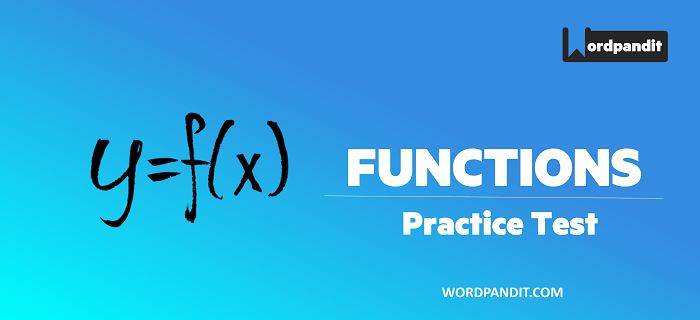- This is an assessment test.
- To draw maximum benefit, study the concepts for the topic concerned.
- Kindly take the tests in this series with a pre-defined schedule.
Algebra: Functions Test-5
Congratulations - you have completed Algebra: Functions Test-5.You scored %%SCORE%% out of %%TOTAL%%.You correct answer percentage: %%PERCENTAGE%% .Your performance has been rated as %%RATING%%
Your answers are highlighted below.
Question 1 |
If x and y are real numbers, the functions are defined as f(x, y) = I x + Y I, F (x, y) = - f (x, y) and G (x, y) = - F (x, y). Now with the help of this information answer the following questions:
If Y = which of the following will give x2 as the final value
f(x, y) G (x, y) 4 | |
G (f (x, y)f(x, y)) F (x, y)/8 | |
- F (x, y) G (x, y)/log216 | |
– f(x, y) G (x, y) F (x, y)/F (3x, 3y) |
Question 1 Explanation:
$ \displaystyle \begin{array}{l}-F\,\left( x,\,\,y \right)\,.\,G\,\left( x,y \right)=-\left[ -\left| \,\,\,\,x+y\,\,\, \right|\,\,\,\,.\,\,\,\,\left| \,\,\,x+y\,\,\, \right|\,\, \right]\\\frac{-\left( -2x.2x \right)}{{{\log }_{2}}16}=4{{x}^{2}}\,\,\,\,\,\,\because \,[{{\log }_{2}}16={{\log }_{2}}{{2}^{4}}=4]\\therefore\,\,option\,\,c\,\,is\,\,the\,\,right\,\,answer\end{array}$
Question 2 |
Using the relation answer the questions given below
@ (A, B) = average of A and B
/(A, B) = product of A and B,
x (A, B) = the result when A is divided by B
The sum of A and B is given by
\ (@ (A, B), 2) | |
@ ( \ (A, B), 2) | |
@ (X (A, B), 2) | |
none of these |
Question 2 Explanation:
Going through the various options
$ \backslash \left( \left( A,B \right),2 \right)=\backslash \left( \frac{A+B}{2},2 \right)=\frac{A+B}{2}\times 2=A+B$
$ \backslash \left( \left( A,B \right),2 \right)=\backslash \left( \frac{A+B}{2},2 \right)=\frac{A+B}{2}\times 2=A+B$
Question 3 |
Using the relation answer the questions given below
@ (A, B) = average of A and B
/(A, B) = product of A and B,
x (A, B) = the result when A is divided by B
The average of A, Band C is given by
@ (x (\ (@ (A, B), 2), C), 3) | |
\ (x (\ (@ (A, B)), C 2)) | |
X (@ (\ (@ (A, B), 2), C,3)) | |
X (\ (@ (\ (@ (A, B), 2), C), 2), 3) |
Question 3 Explanation:
$ \displaystyle \begin{array}{l}(a)\,\,\text{ }\left( x\text{ }\left( \backslash \text{ }\left( \text{ }\left( A,\text{ }B \right),\text{ }2 \right),\text{ }C \right),\text{ }3 \right)=\text{ }\text{ }(x\text{ }(\backslash \left( \frac{A+B}{2},2 \right),C),\text{ }3)\\=\text{ }\left( x\text{ }\left( A+B,\text{ }C \right),\text{ }3 \right)\\=\left( \frac{A+B}{C},3 \right)\\\left( b \right)\text{ }\backslash \text{ }\left( x\text{ }\left( \backslash \text{ }\left( \text{ }\left( A,\text{ }B \right) \right),\text{ }C\text{ }2 \right) \right)\\=\text{ }\!\!\backslash\!\!\text{ }\left( x\left( \backslash \left( \frac{A+B}{2},C\,2 \right) \right) \right)\\=\backslash \left( x\left( \frac{A+B}{2}\times C\,2 \right) \right)\\(c)X\left( \left( \backslash \left( \left( A,B \right),2 \right),C,3 \right) \right)\\=X\left( \left( \backslash \left( \frac{A+B}{2},2 \right),C,3 \right) \right)\\=X\left( \left( A+B,C,3 \right) \right)\\=X\left( \frac{A+B+C}{2},3 \right)=\frac{A+B+C}{6}\\(d)\,X\left( \backslash \left( \left( \backslash \left( \left( A,B \right),2 \right),C \right),2 \right),3 \right)\\=X\left( \backslash \left( \left( \backslash \left( \left( A,B \right),2 \right),C \right),2 \right),3 \right)\\=X\left( \backslash \left( \left( \backslash \left( \frac{A+B}{2},2 \right),C \right),2 \right),3 \right)\\=X\left( \backslash \left( \left( A+B,C \right),2 \right),3 \right)\\=X\left( \backslash \left( \frac{A+B+C}{2},2 \right),3 \right)\\=X\left( \backslash \left( A+B+C,3 \right) \right)=\frac{A+B+C}{3}\end{array}$
Question 4 |
x and yare non-zero real numbersf (x, y) = + (x +y)0.5,if (x +y)0.5is real otherwise = (x +y)2g (x, y) = (x +y)2 if (x + y)0.5is real, otherwise =- (x +y)For which of the following is f (x, y) necessarily greater than g (x, y)option
x and y are positive | |
x and y are negative | |
x and y are greater than - 1 | |
None of these |
Question 4 Explanation:
When both x and y are positive
f (x, y) = + (x +y)0.5g (x, y) = (x +y)2 so g(x,y)>f(x,y)
When both x and y are negative
f(x, y) = (x +y)2g (x, y) = -(x +y)
If x+y>-1
g(x,y)>f(x,y)
When x and y are greater than -1. They can be both positive as well as in the range 0 to -1
so both a and b option cases arise.
f (x, y) = + (x +y)0.5g (x, y) = (x +y)2 so g(x,y)>f(x,y)
When both x and y are negative
f(x, y) = (x +y)2g (x, y) = -(x +y)
If x+y>-1
g(x,y)>f(x,y)
When x and y are greater than -1. They can be both positive as well as in the range 0 to -1
so both a and b option cases arise.
Question 5 |
x and yare non-zero real numbers
f (x, y) = + (x +y)0.5,if (x +y)0.5is real otherwise = (x +y)2
g (x, y) = (x +y)2 if (x + y)0.5is real, otherwise =- (x +y)
Which of the following is necessarily false?
f(x,y) >g(x,y) for 0 | |
f(x,y) > g (x,y) when x,y<-1 | |
f (x, y) > g (x, y) for x, y > 1 | |
None of these |
Question 5 Explanation:
In this case ,f (x, y) = + (x +y)0.5 g (x, y) = (x +y)2
This is true cause (x+y)<1 for which (x +y)0.5>(x +y)2
In this case, f(x, y) = (x +y)2 g (x, y) = -(x +y)
This is also true cause for (x+y)<-2 (x +y)2>-(x+y)
In this case f (x, y) = + (x +y)0.5 g (x, y) = (x +y)2
This is false because for(x+y)>2 (x +y)2>(x +y)0.5
So the answer is c
This is true cause (x+y)<1 for which (x +y)0.5>(x +y)2
In this case, f(x, y) = (x +y)2 g (x, y) = -(x +y)
This is also true cause for (x+y)<-2 (x +y)2>-(x+y)
In this case f (x, y) = + (x +y)0.5 g (x, y) = (x +y)2
This is false because for(x+y)>2 (x +y)2>(x +y)0.5
So the answer is c
Once you are finished, click the button below. Any items you have not completed will be marked incorrect.
There are 5 questions to complete.
List |






